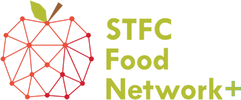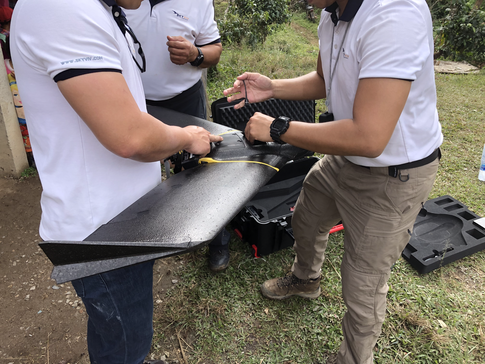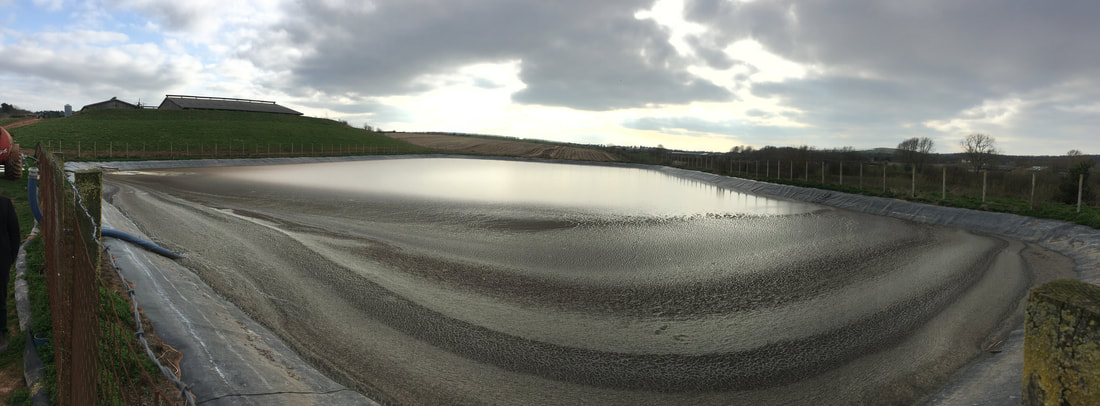 Typical symptoms of a coffee plant infected with coffee rust (Oliver Windram) Typical symptoms of a coffee plant infected with coffee rust (Oliver Windram) Specially-equipped drones could soon help small holder farmers control one of the deadliest killers of coffee plants. Coffee is one of the most traded agricultural commodities and has become a lifeline for many developing regions in the world. This includes the Chiang Mai region in Thailand, where the government is on a mission to become the ‘coffee capital of South-East Asia’, focusing on the premium Arabica varieties. But these ambitions could be jeopardised by a parasitic fungus. Coffee leaf rust is a global disease which attacks the leaves of coffee plants, ultimately decimating the coffee bean harvest. The fungal spores spread easily via wind and rain, meaning that a single outbreak can wipe out plantations over entire regions. Sri Lanka, for instance, was once exclusively planted with coffee until a coffee leaf rust epidemic in 1892 destroyed all of the trees, prompting the farmers to plant tea instead. With fungicides being prohibitively expensive and not an option for organically-certified farms, the only way smallholder farmers can control the parasite is to remove infected plants as soon as possible. Yet even this is currently a challenge – although this STFC-funded project could soon make the process much easier. “It’s very difficult for these farmers to monitor coffee leaf rust, because the plantations are often on the sides of rugged mountains and intercropped with different species: very different from the neat rows we have on UK farms” explains Anthony Brown (Durham University). He first became aware of the problem of coffee leaf rust when he was introduced via the STFC Food Network+ to Oliver Windram, a researcher of remote-sensing technologies for crop plants (Imperial College, London). Oliver’s earlier research in plant pathology had uncovered a real need within agriculture for methods that could quantitatively measure plant disease in the field. This led him to develop remote-sensing technologies for measuring disease on wheat and broccoli, using machine learning to detect and quantify infection. Together, Oliver and Anthony proposed an image-based detection system using drones that could easily fly over the hillsides, allowing infected plants to be identified much more quickly. This draws on Anthony’s expertise in data analytics and unmanned aerial vehicles, and is based on recording spectral data. Their method measures the wavelengths of light reflected off the surface of the plant leaves and records how the intensity of light varies as a function of frequency. The result is a ‘heatmap’ where a large difference in signal intensity indicates the presence of coffee leaf rust. The project began with field visits to coffee plantations in Thailand to test which wavelengths could most accurately discriminate between healthy and infected plants. This in itself proved an experience: “It was the first time I realised that coffee berries are actually red!” Anthony jokes. The team walked among the plants with spectroscopes to compare the signatures of reflected light from uninfected plants and those with varying degrees of coffee leaf rust. Unfortunately, the optimum wavelengths all fell within a range not covered by commercially-available cameras. “When we tried using off-the-shelf cameras, the images were just not sensitive enough to detect coffee leaf rust. But it is important that this solution is affordable for farmers, who are the ultimate end-users” says Anthony. For this reason, they are now engaging with industrial partners to develop a bespoke filter that would enable a commercial camera to read these wavelengths. Anthony and Oliver hope that by January 2020 the prototype will be ready to undertake proof-of-concept flights over plantations in Thailand. Focusing on the end-user and engaging them throughout the planning stages also made the team realise that there was another potential application for this technique. “Farmers are really keen to know exactly what varieties of Arabica coffee they have, since pure products can command better prices. But there are very few records for these areas” Anthony says. He is confident, however, that spectral imaging could distinguish between them, potentially opening up new markets for small holders. “Interacting with end-users to learn what is important for them – rather than just assuming what they need - has been one of the most rewarding aspects of this project” he says. Nevertheless, interest in this work has also had a “snowball” effect in opening up a plethora of new research opportunities for him. “Through my work for the STFC Food Network+, I have now been invited to collaborate on projects using remote sensing to understand global warming impacts on trees across Europe and Africa, besides mangrove forests in South America”. The experience has certainly made him keen to be involved with more interdisciplinary projects that combine different skill sets to create novel solutions, and credits the STFC Food Network+ for encouraging these opportunities as part of its fundamental strategy. “Applying your expertise from one field to another can take you out of your comfort zone, but also be some of the most impactful work that you do” he concludes.
0 Comments
 As part of their research, Daniel and his colleagues visited a UK dairy farm. Photo Credit: Daniel Gerber As part of their research, Daniel and his colleagues visited a UK dairy farm. Photo Credit: Daniel Gerber Air pollution has been described as one of the UK’s most severe public health challenges and also damages natural environments. One of the most concerning pollutants is ammonia: besides forming smog and particulate matter that can cause cardiovascular and respiratory disease, it also deposits excess nitrogen in habitats, which reduces biodiversity. Most (88%) of ammonia emissions originate from agriculture, particularly from manure and inorganic fertilisers. Worryingly, unlike other air pollutants such as nitrogen oxides, ammonia emissions are actually increasing and are consequently a key component of the UK Government’s 2019 Clean Air Strategy. But whilst government, industry and researchers agree this trend must be reversed, they face a key obstacle in doing so: measuring ammonia emissions remains no easy task indeed. “It is really important that we are able to accurately measure ammonia emissions from agriculture” says Daniel Gerber, of STFC Rutherford Appleton Laboratory. “At the moment, most UK studies use wind tunnels to measure ammonia emissions: these are typically 2 metres long and funnel air through a liquid acid, which is analysed later in a laboratory. Although this does work, it is slow and requires significant person power”. A physicist by training, Daniel’s work usually involves equipping space missions with highly sensitive instruments to detect radiation in outer space, rather than more ‘down to earth problems’. Indeed, Daniel wasn’t even aware of how severe the problem of ammonia emissions in the UK was until his group leader Brian Ellison (STFC RAL Space) attended a STFC Food Network+ Sandpit event in March 2018. Here he was introduced to Lizzie Sagoo from ADAS, an agricultural and environmental consultancy, who asked if his methods could be applied to measure ammonia emissions on the ground. This presented a stimulating challenge for Daniel and his colleagues: “Although our technology can detect ammonia in outer space, measuring it from earth is a completely different scenario. Since space is a vacuum, it is a benign environment for making measurements but in earth’s atmosphere you have other air particles, winds and temperature variations to contend with. We weren’t sure if it could work”. Brian and Lizzie submitted a proposal for an STFC Food Network+ Scoping Grant, to fund a project that would investigate if remote measuring of ammonia emissions was theoretically possible. This was ultimately successful and, starting at the very beginning, the team first worked out which, if any, radio frequencies could be used for detecting ammonia. Every molecule emits tiny radiowave signals, in the form of electromagnetic waves produced by charged particles within the atoms. The frequency of these waves is characteristic of the molecule’s structure; hence a specific gas can be measured by detecting the strength of its characteristic frequency signature. However, these signals can be weakened by other gases in the atmosphere, especially water vapour. This presents a compromise as Daniel explains: “Low frequency signals are less attenuated in the atmosphere but they also tend to be weaker to begin with, so are harder to detect”. Nevertheless, using models of the atmosphere and simulations, he and his colleagues identified a handful of signals that could be potentially viable. These results enabled them to secure a STFC Proof-of-Concept grant to start designing a prototype instrument. “We envisage that the instrument will be about the size of a small fridge, that could be towed into a field on a trailer or mounted on a wall” Daniel says. Crucially, it would be capable of measuring in real time, allowing it to detect any sudden surges in emissions which could then be investigated. A portable, easy-to-use instrument would also enable a much denser data map of ammonia emissions across the UK. This could ultimately help farmers make informed choices on when and how to spread manure and to assess whether current storage facilities adequately restrict emissions. These potential gains aptly illustrate the STFC Food Network+’s commitment to support projects that can deliver measurable impact towards a sustainable agricultural sector. “Without the STFC Food Network+, we would not have realised the value of an instrument to measure ammonia on the ground” Daniel says. He also stresses how important it was to interact with real people in order to truly understand what was needed. “Our conversations made us realise that ease of use and operation were more critical than using our space heritage to develop a supremely sensitive instrument. We were also able to visit a farm and see the conditions where it would be used: with dust in the air and mud everywhere, it was clear that this instrument couldn’t only be suited to a clean laboratory environment!” Besides the cognitive challenge, Daniel has enjoyed the rich experiences the project has brought. “I normally spend all day in clean offices, then suddenly I was pulling on wellies and wading through manure on farms…” he says. Despite the muck, he is keen to become involved in more interdisciplinary work. “This project has made me wonder how many other potential applications that we are not aware of could benefit from our technology… the challenge now is to connect with and meet those users.” After all, you can only begin to try and solve a problem once you know about it. It sums up the STFC Food Network+‘s ethos perfectly: bringing together those with a need with those that have a potential solution. |
AuthorJune 2024 - Archives
June 2024
Categories |
- Home
- Webinars and Events
- About the SFN+
- News
- Blog
- Expert Working Groups
- Funding
-
Publications
- Bioeconomy positioning paper
- SFN+ 5th Annual Conference
- OMM Policy Report
- ‘Multi-Stakeholder International One Day Workshop on Organic Agri-Food Value Chains for Net Zero’ Report
- SFN 2050 UK Net Zero Food report
- Sustainable Cold Food Chain Booklet
- Food Sensing Technologies for Safe and Nutritious Food
- Sustainable urban and vertical farming
- Projects
- Join/Contact Us



 RSS Feed
RSS Feed


